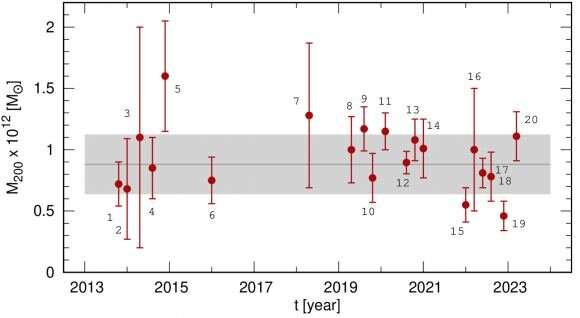How do you weigh a galaxy? It’s an astronomical challenge, particularly if it’s the galaxy you call home. It turns out there are several ways to get a handle on the mass of the Milky Way, and a recent study posted on the arXiv pre-print server summarizes these methods to present the best value.
One method is to look at the motion of stars in the galaxy. Most Milky Way stars follow a roughly circular path around the galactic center. Just as planets orbit the Sun, stars orbit the galaxy. Since gravity is the force holding stars in their orbit, you can use a star’s speed and distance from the center to determine the mass within its orbit. Not all stars have circular orbits, but they do on average. So you can plot the speed vs. distance from the center for known stars, and get what is known as the rotation curve. Measurements of this curve in the Milky Way and other galaxies were the first evidence that galaxies had much more mass than could be accounted for by visible stars, leading to the idea of dark matter.
One of the problems with the rotation curve method is that we can only measure stars to a certain distance. We now know that most of our galaxy’s mass isn’t concentrated at the center, but rather extends outward into a galactic halo. We can estimate the mass of the halo from the rotation curve, but we can also look at the motion of globular clusters.
Globular clusters are bright dense clusters of stars. Since stars within a globular cluster are gravitationally bound, these clusters move around the galaxy like a single object. They are found in a sphere surrounding the Milky Way, so measuring their motion helps us measure the mass of the galactic halo.

To measure the outer region of the galactic halo, we can look at the motion of satellite galaxies such as the Magellanic Clouds. There are about 60 small galaxies within about 1.4 million light-years of the Milky Way. Not all of them are in orbit around our galaxy, but many of them are. Since they lay outside our galactic halo, their orbital motions are determined by all of our galaxy’s mass. The only downside of this approach is that with only a few dozen orbiting galaxies, the result isn’t particularly accurate.
All of these approaches calculate the mass of the Milky Way from orbital motion. There are a few methods that don’t rely on the orbital motion. One of these is to look at the tidal plumes of dwarf galaxies. In the history of our galaxy, there are some globular clusters and dwarf galaxies that strayed too close to the central region of the Milky Way and were ripped apart by tidal forces. The remnants of these galaxies form a stream of stars, such as the Sagittarius stream. By calculating the motion of these streams we can estimate galactic mass.
Another approach is to look at stars leaving our galaxy. Occasionally a star will have a near miss with another star and gain enough velocity to escape our galaxy. Since the escape velocity depends on galactic mass, a statistical measure of escaping stars gives a mass for the galaxy.
Finally, we can look at the local group of galaxies. This includes the Andromeda galaxy and its satellite galaxies. Our local group is gravitationally isolated from more distant galaxy clusters, so looking at the equilibrium state of the local group gives us a handle on its overall mass and the mass of the Milky Way.
Each of these approaches has its own advantages and levels of accuracy. None of them are the final say on their own. In this latest work, the team took a statistical average of various methods and derived what we might call the best value for the mass of our galaxy. The value they determined was a trillion solar masses, give or take a few hundred billion solar masses.
More information:
V. V. Bobylev et al, Review of current estimates of the Galaxy mass, arXiv (2023). DOI: 10.48550/arxiv.2305.18408
Citation:
Exactly how massive is the Milky Way? (2023, June 2)
retrieved 3 June 2023
from https://phys.org/news/2023-06-massive-milky.html
This document is subject to copyright. Apart from any fair dealing for the purpose of private study or research, no
part may be reproduced without the written permission. The content is provided for information purposes only.

